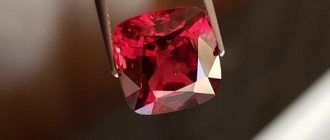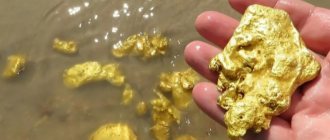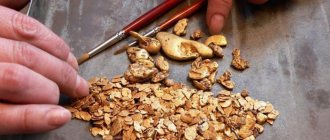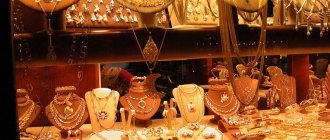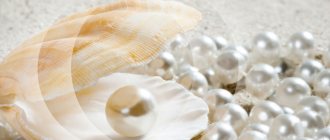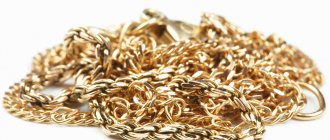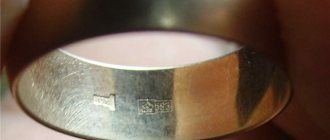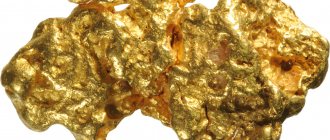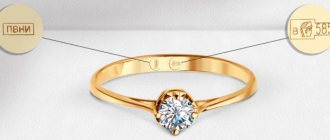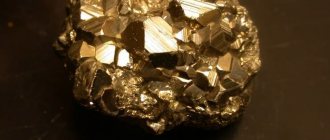№1
It is number 79 on Mendeleev's periodic table. It is almost 2 times heavier than iron, but it is very easy to process. Most likely, due to its ease of processing, it was the first metal used by man.
Ancient artifacts made of processed gold from the Thracian civilization (modern Bulgaria) are more than 4000 years old.
The mask of the ancient Egyptian pharaoh Tutankhamun contains almost 100 kg of pure gold. Although it has been present in different cultures for thousands of years, almost all of the gold currently in human possession has been mined since 1848 (more than 90%).
Historical facts about gold
1. The word "gold" comes from the Old English word "gyldan", which came from the Germanic word "gulþa".
2. People mined about 200,000 tons of gold.
3. Since 1950, 2/3 of above-ground gold has been mined.
4. Gold has been found on all seven continents.
5. It is estimated that there are about 10 billion tons of gold in the world's oceans. However, it is so diluted that it is impossible to obtain.
6. The transformation of ordinary materials into gold is called chrysopoeia.
7. The carat was originally a unit of mass based on the carob seed used by ancient merchants.
8. The oldest gold object was discovered in Bulgaria. The discovery showed that people were processing this material as early as 6,500 years ago.
9. Since the times of Greco-Roman Egypt, alchemists have believed that it was possible to turn common materials such as lead into gold.
10. The biggest nugget that still exists is the Hand of Faith. Discovered using a metal detector in Australia in 1980, you can see it at the Golden Nugget Casino in Las Vegas.
11. Olympic gold medals were pure gold until 1912. They are currently required to contain a minimum of 6 grams of gold and be made from at least 92% silver.
12. In the Aztec language, gold "teocuitatl" is translated as "excrement of the gods."
13. About 50 years before the California Gold Rush of 1848, there was a gold rush in North Carolina.
№2
It is an excellent conductor. It conducts heat and electricity well, although not as well as copper and silver. Because this metal resists oxidation and corrosion, it continues to move electrons even if it is occasionally exposed to the atmosphere. It is for this reason that the surfaces of electrical contacts are coated with gold plating.
Use of gold in medicine
Modern healers use radioactive precious metal in the form of a colloidal solution in chemotherapy for the treatment of cancer. In another method, gold nanoparticles introduced into a malignant tumor, under the influence of infrared rays, destroy deadly cells without damaging healthy tissue.
Plastic surgery is also a proponent of such miracles. For the purpose of rejuvenation, gold threads are introduced under the skin to promote the formation of a collagen framework for the skin.
Preparations containing gold particles are also successfully used in the treatment of various arthritis.
№4
Where did it come from on Earth? Scientists have a theory according to which all the gold on our planet came from space. Geologists believe that it fell to Earth during meteor showers that occurred on Earth more than 2 billion years ago. It is believed that these meteorites appeared on Earth after the collision of exotic stars.
The influence of gold on humans
Since ancient times, the value of gold has been measured not only from a material point of view. It was believed to have the ability to treat neurological disorders and heart disease. Paracelsus is credited with introducing gold into medicine.
Back in the 6th century, a Treatise was published telling about drinking gold. It talked about the miraculous drink of Arab alchemists. It was a red colloidal solution of finely crushed gold. The Chinese called this drink the “elixir of life,” which bestows inexhaustible vital energy, strength and health.
Interesting facts about gold are revealed by modern scientists. They discovered that the chemical element is found in negligible amounts in human blood and has a physiological effect on the body. Modern medicine confirms the beneficial effects of gold on humans. Wearing jewelry from them gives a good mood, helps to get rid of depression and hysterical states. An interesting thing about gold is that it increases blood pressure, accelerates metabolic processes, and has a bactericidal effect.
№5
Today, many countries, in particular Russia and China, are rapidly increasing their reserves of this metal. However, they are still far from the United States of America. Currently, the US Federal Reserve Bank, located in New York, stores the largest reserves of this metal (about 6800 tons). This vault holds more than 540,000 gold bars, representing approximately 25% of all gold mined in the world. But it is worth noting that most of this metal belongs to foreign governments.
Financial Facts About Gold
24. Gold is the most popular precious metal for investment.
25. The price of gold fluctuates constantly and is often associated with major economic events.
26. Before 1971, the currencies of most Western economies were on the gold standard.
27. Gold is no longer the most expensive metal. That honor went to palladium in 2022.
28. Switzerland was the last country to abandon the gold exchange standard. 40% of the Swiss franc was backed by gold until the Alpine country joined the IMF in 1999.
29. King Croesus of Lydia created the first pure gold coins in 540 BC.
30. Henry VIII, Diocletian and Nero were notorious desecrators of gold, mixing other metals into gold coins and reducing their value.
№13
Most of the gold is mined in South Africa. The mining conditions there are not the most favorable. Mines very often go to depths of up to 4 km, where temperatures can rise to 54 degrees Celsius. Mining 28 grams of gold requires about 6,500 liters of water, 38 man-hours and a large amount of electricity, which would be enough to run an average home for 10 days.
We also recommend reading: Interesting facts about tea
Facts about Fort Knox
31. As of the end of March 2022, Fort Knox contained more than 4,500 metric tons of gold.
32. Fort Knox contains about 50% of the gold reserves of the United States.
33. Fort Knox is believed to contain about 2% of the world's gold reserves.
34. Fort Knox was never sacked. In fact, no one has even attempted such an operation. With 30,000 troops, a surrounding minefield, Predator drones conducting routine surveillance, and 20-ton vault doors, this is impossible.
№14
The world's largest gold nugget was found in 1869 by two Britons, John Dizon and Richard Oates, in central Victoria, Australia. The nugget had a mass of 78 kg, and when it was processed, it was possible to obtain about 71 kg of pure gold. It is worth noting that nuggets are a rare occurrence. Of all the gold mined, nuggets account for about 2%.
Scientific facts about gold
14. The chemical symbol for gold is Au, which comes from the Latin word “aurum,” or “blazing dawn.”
15. A noble metal, gold, does not rust, does not tarnish, and does not form an oxide film on its surface when in contact with air.
16. Because this precious metal is virtually indestructible, it is usually melted, refined, and reused. This means your gold ring could have particles from Ancient Rome on it!
17. Today's world standard of 200 mg metric carats was established in 1907, and the United States adopted this measurement method in 1913. Previously, standards ranged from 187 mg to 215.99 mg.
18. Of the 92 naturally occurring elements, gold ranks 58th in rarity. The rarest elements on Earth are platinum-based metals such as osmium, rhodium and iridium.
19. Pure gold is so soft that it can be sculpted by hand.
20. The melting point of gold is 1064 °C.
21. Almost all of the Earth's gold was obtained from meteorites 200 million years ago.
22. Some rheumatoid arthritis patients receive injections of liquid gold to reduce inflammation.
23. During earthquakes, water inside faults can break down and evaporate, forming gold.
Where and how is solar metal mined?
Gold is an extremely rare metal. It is believed that the bulk of the metal present on earth is concentrated in the planet's core. And those deposits that humanity has discovered throughout its history are “sprays” that fell into the earth’s crust when it was bombarded by asteroids during the formation of land.
But it is to gold that people owe the beginning of the era of metal processing. The most ancient valuable items found by archaeologists have existed for six and a half thousand years.
The oldest gold deposit was located in Ancient Egypt, between the Nile River and the Red Sea. Almost 6 thousand tons of solar metal were mined there. The Egyptians obtained gold by washing metal-rich sand.
The extraction of valuable metal these days is a combination of geological exploration activities with the use of modern equipment. The current mine begins with exploration of the deposit and determination of its area. Then economic calculations and efficiency analysis are carried out. If a mine is capable of making a profit, it is equipped with hydraulic equipment or dredges. In both the first and second cases, the extraction process consists of the same washing of gold-bearing rock or sand. Only in a modern mine this is done not by miners, but by machines.
Around the world, gold is produced in 70 countries. The largest producers are South Africa, Canada, Australia, the United States, and Russia.
What is the golden ratio
The precious chemical element has always been used as a standard, an ideal measure of something. Thanks to this, the word “golden” itself acquired the meaning of great, perfect, supreme. People call a kind and sympathetic heart golden. This is the name of hardworking and inventive hands. “Golden man” - they say about someone who has accomplished a significant feat or shown the best qualities.
Likewise, the golden ratio is the name given to the formula of mathematical proportion, the application of which in art leads to the achievement of the ideal. From the point of view of science, the golden ratio is a formula expressing the division of a segment into two unequal ones. In this case, the smaller relates to the larger in the same way as the larger to the first. This ratio has a golden ratio of 1.62.
The application of the rule is seen in the proportions of Egyptian pyramids and tombs, in ancient Greek sculptures and paintings of the Renaissance, as well as in many natural objects.
The appearance of the concept of the golden ratio is associated with the work of Leonardo da Vinci. The principle of this proportion is often seen in his creations.
Interesting facts about the golden ratio were studied by Fibonacci. He derived a number sequence, a kind of spiral equation. Subsequently, it began to be called the spiral golden ratio, or the Fibonacci principle.
Currently, photographers and artists use the rule to create a perfectly harmonious composition.
Gold of the Ancient World
Everything related to the history of the precious metal is very interesting. There are many legends about gold. And ancient civilizations considered this metal to be the flesh and blood of the gods.
The Egyptians, who discovered the largest deposit, perfectly mastered the art of making alloys. They used gold of various shades to make jewelry and religious objects.
In Ancient Greece, the solar metal was also personified with the creation of the earth. Gold was used for all divine attributes. Interesting information is contained in ancient Greek myths. The sun god Zeus possessed a golden trident. The sun god Helios rode across the sky in a solar chariot and sailed on a boat of their precious metal.
LiveInternetLiveInternet
According to archaeologists, the first gold was mined in the Middle East back in the 3rd millennium BC. e. Almost immediately after becoming acquainted with this noble metal, it was elevated to the rank of value, and gold began to be used as a kind of equivalent of money much later. Gold has caused many wars, the collapse of human destinies and the destruction of entire civilizations! No metal is stained with as much blood as gold, but its sinister history in no way detracts from its attractiveness to people at all times. People die for metal... What do we even know about gold?
Gold and its properties. According to the Periodic Table, gold is element number 79, Aurum, which belongs to the group of precious metals. Gold has significant density: a ton of gold is a cube with a side of only 37.27 cm. Gold is a very ductile and soft metal; it can be rolled into sheets up to 0.0001 mm thick. (“leaf” gold), and from one gram draw a wire 3.5 km long.
Gold does not oxidize in air and is resistant to moisture, insensitive to acids, alkalis and salts. The exceptions are a mixture of hydrochloric and nitric acids in a ratio of 3/1 (regia vodka), sulfuric acid in combination with manganese or nitric acid, as well as hot selenic acid, in which gold dissolves quite easily. When combined with mercury, gold forms an amalgam (once this property of gold was used for “hot” gilding of jewelry: the jewelry was rubbed with amalgam and heated over hot charcoal; when heated, the mercury evaporated, and a thin layer of pure gold remained on the product). Pure gold is too soft for items made from it to retain their shape. Jewelry is made from alloys of gold with other metals, most often silver or copper. The amount of pure gold in the alloy is determined by the sample. For example, in a 585 alloy there is 0.585 mg per 1 gram. gold. In an alloy of 960 gold, 1 gram of alloy accounts for 0.96 mg. gold and 0.3 mg. silver
Gold in nature.
If we compare the amount of gold with the total mass of our planet, we get only 0.3 g per ton! In this case, the mass of the Earth’s core is taken into account, in which there is at least 5 times more gold than in the rocks available for mining. About 0.02 mg of gold is dissolved in every liter of sea and ocean water. Gold is found in the form of nuggets or as an alloy with silver. This alloy is called “electr”. Geologists claim that all gold-bearing corners of the planet have already been explored, and estimate the mass of the precious metal at 120-150 thousand tons. Moreover, these deposits are less rich and accessible than those already developed. The largest nugget on the planet is “The Welcome Guest,” found in Australia in 1869. His weight was about 71 kg. In Russia, the largest find of prospectors weighed 36 kg; this nugget was found in the Urals in 1842. Gigantomania. The largest golden statue was cast by order of the Assyrian queen Semiramis. The statue of the goddess Rhea, seated on a throne surrounded by golden lions, weighed 250 tons! Another sacrificial statue, which took “only” 30 tons of pure gold to make, was 12 meters high! Sarai-Batu, the capital of the Golden Horde, was decorated with life-size statues of two golden horses, made by order of Batu Khan as a sign of his power. During the reign of Mamai, these statues were irretrievably lost. Where they are now is another unsolved mystery of history. The Great Inca Atautalpa was a leader for whose life the largest ransom in human history was offered. The gold intended for the conquistadors, who captured the Inca leader, was transported in a caravan of 11 thousand lamas! The Indians were ready to fill a 50 m2 room with gold, but the conquistadors still killed the leader. Among the treasures was a huge golden chain that required 200 soldiers to carry.
Gold reserve. The largest national gold fund today is in the USA (about 8 thousand tons). Then there are the vaults of the International Monetary Fund and Germany. India is ahead of the rest of the world in terms of the number of gold jewelry. The largest personal gold reserve is in one of the royal families in the East. If you go deeper into history, the richest civilizations were Ancient Egypt and the Inca Empire.
Recipe for the "philosopher's stone"
During the Middle Ages, the passion for alchemy was widespread. Each scientist considered it his duty to contribute to the recipe for the “philosopher’s stone.” In the 14th century, the English king Henry IV even issued a special law: “No one, no matter who he is, is allowed to turn base metals into gold.” For 6 whole centuries this law was not violated! And only in the twentieth century, with the development of atomic physics, it became possible to obtain radioactive isotopes of gold using specific nuclear processes.
In France, the activities of alchemists were not regulated by law. The bloodiest fact that went down in history was the murder of 800 young girls. Yes, the French Marshal Gilles de La Val Baron du Retz, better known as “Bluebeard,” was accused by the church of using the blood of his victims to obtain gold from other metals.
Bonanza.
During the era of Spanish maritime dominance, caravans of ships were equipped to transport huge quantities of looted gold. They were called that - Golden Galleons, Golden Fleet. Bad weather and a large number of pirates have led to the fact that even now more than 100 such ships rest at the bottom of the Caribbean Sea. About 70 galleons of the Golden Fleet sank in the Gulf of Mexico, and Bermuda and the Bahamas became the final refuge of another 60 “gold bearers.” According to rough estimates by historians, the cargo of just one of them, the Santa Rosa, is estimated at $35 million. Unfortunately, many years of attempts to raise the treasures have invariably ended in failure.
Gold dust. High-grade gold, from which coins were made, is prone to the formation of gold dust. Therefore, coins that had been in circulation for quite a long time lost a fair amount of weight. Particularly enterprising people have found a way to get rich from this. At the beginning of the twentieth century, the cashier of one of the large European banks tried to get rich from gold dust. His duties included sorting, counting and packaging coins. This employee showed miracles of accuracy: when he came to work, he carefully covered the table with a cloth, on which he performed all the manipulations with gold coins. By burning the fabric in a frying pan at the end of each work week, the cunning man received a small gold bar! At the end of the 19th century in Philadelphia, someone (history is silent about the name of the hero) purchased for $3,000... the roof of an old church that had not seen repairs for several decades. For what? Gold dust was an indispensable companion of mints, one of which was adjacent to the old church. Naturally, it settled on nearby buildings. Having scraped off the paint from the dilapidated roof, the resourceful American burned it, and in the ash he collected gold particles with a total weight of 8 kg!
Golden "attractions"
In one of the fashionable resorts of Japan - Funabara - there is a very interesting “attraction” - a golden bath. The hotel in which it is installed is extremely popular. True, in recent years, those wishing to bathe in the most expensive font have been searched by security guards - attempts have been seen to smuggle in tools and break off a piece of the bath “as a souvenir.” One woman became famous for breaking her jaw while trying to bite off the side of a bathtub. It is noteworthy that the idea of gold plumbing is not new at all. Look what V.I. wrote in 1919. Lenin: “When we win on a global scale, I think we will make public latrines out of gold on the streets of several of the largest cities in the world.” According to rumors, a golden toilet was installed in the Moscow apartment of singer Alsou about 4 years ago - the “oil” dad believes that his daughter deserves everything most unusual.
Gold and health. Everyone knows that until recently, the use of gold crowns was the best method of dental prosthetics. An Italian dentist was the first to use gold in dentistry back in the 16th century: he fastened the remaining teeth with gold wires. The use of gold today is not limited to dentistry. Gold reinforcement is a fairly popular way to prolong youth. The essence of the method is to “pull” gold threads under the skin of the face and body. Gold stimulates the production of substances that maintain elasticity, and therefore youthfulness of the skin. The effect lasts 6-8 years. According to rumors, ballerina Maya Plisetskaya has about 2 kg of gold threads in her body! Catherine Deneuve, Julia Roberts, and Laima Vaikule resorted to this technique. Gold ions are added to creams and masks - women are happy.
Golden etiquette. During the gallant era of the monarchy, there were quite strict rules for wearing gold jewelry. Moreover, in the 19th and early 20th centuries, etiquette was international: both in the English, and in the German, French and Russian royal courts, the rules were almost the same. The amount of precious jewelry was strictly regulated on many points: title, belonging to a particular family, age and, finally, the nature of the reception (for a daytime reception you had to wear the most modest jewelry, an evening one gave more scope for displaying the contents of family safes, for a reception into the royal family ladies always wore tiaras). Nowadays, there are also certain rules for choosing gold jewelry. It is not recommended to wear jewelry made of different types of gold at the same time, for example, white and red. Chains made of gold and silver are not worn at the same time. A sign of bad taste is more than three rings on the fingers of one hand. It is unlikely that anyone would consider massive gold earrings with stones in the ears of a young girl to be appropriate.
Gold... on your table. The height of extravagance was the Frozen Haute Chocolate dessert. This $25,000 marvel is served at the trendy Manhattan restaurant Serendipity -3. True, for now on pre-order. The dish contains cocoa beans from different countries (14 varieties in total), whipped cream prepared in a special way, and 23-karat gold - 5 grams per serving. The ice cream comes with chocolate truffles. Interestingly, you can take the diamond-encrusted spoon served with dessert with you. Previously, the finest gold threads were used only as decoration for the masterpiece cakes and pastries of the Parisian Maxim restaurant. Producers of elite types of alcohol also never tire of surprising their customers: French ultra-premium vodka - the Gold flakes supreme class - contains flakes of 24-karat gold. The elegant 750 ml bottle is already delighting aesthetes and gourmets around the world. The issue price is about 60 dollars.
Gold and beauty. No one has ever tried to dispute that gold is beautiful. In every time, in every nation, goldsmiths were highly respected, because genuine masterpieces came out of their hands. Masks of the pharaohs of ancient Egypt, giant golden disks with images of the Sun and Moon of the Inca Empire, family cups and golden dishes of medieval Europe, the rarest beauty of church utensils of the Templar era, magnificent Faberge eggs, scatterings of jewelry from residents of eastern harems - to list golden masterpieces that have not only artistic, but also the historical value is endless! Gold was used to make amulets, and belief in the ability of gold to protect its owner from the evil eye, envy and other evil forces continues to this day. Gold jewelry is given upon marriage (there are nations in whose traditions the number of gold gifts to the bride is still calculated in kilograms), on the day of majority, on the occasion of the birth of a child... The life path of each of us is marked by our own golden milestones. Despite the controversial, sometimes bloody history of this metal, its calm beauty and grandeur are a guarantee of enduring value. Life is short - gold is forever!
Mephistopheles
“Mephistopheles” is an unusual nugget weighing 20.2 grams, stored in the collection of the Diamond State Fund of Russia. It was found by gold miners in one of the mines in Chukotka in mid-1944. The piece of gold got its name due to its unusual shape, reminiscent of the profile of the literary character in the book “The Tale of Doctor Faustus,” Mephistopheles. It was initially assumed that the nugget had undergone pre-treatment before entering the museum, but long-term research showed that its shape was natural and not artificial.
Camel
“Camel” is an unusual gold nugget, the shape of which resembles the outline of the body of the animal of the same name. It was found by Russian miners in the depths of a mine in Kolyma in 1947. The weight of the piece of precious metal was 9,300 grams. It was not melted down, but transferred to the collection of the Diamond State Fund, where it became one of the main exhibits. All visitors to the annual exhibition can look at the rare and unique nugget.
Why is metal noble?
Gold is one of the noble metals. This group also includes silver, platinum, rhodium, ruthenium, iridium, palladium and ismium. Metals are very reluctant to react with any elements and at ordinary temperatures are practically not susceptible to chemical influences.
You might be interested: “Drizzle” is about unpleasant but solvable everyday problems
Gold does not oxidize under the influence of oxygen and does not dissolve in water. Its state can be changed only in a special mixture of nitrous and hydrochloric acids. These interesting properties of gold allow it to retain its original shine, color and structure. For such “persistence” it received the title of the highest, noble metal.
bunny ears
In the Urals, near the small settlement of Leninsk, one of the largest gold mines in Russia, discovered under Alexander I, operated for many years. At the beginning of 1935, when the gold mine was preparing to close, a lonely prospector Pyotr Simonov accidentally discovered a piece of gold in the ground, the weight of which exceeded 3.3 kilograms. But the nugget was considered unique not because of its mass, but because of its shape. It resembled a hare's head with long ears.
According to the laws of that time, such a large piece of gold could not remain the property of Simonov and he had to give it to the state. The nugget was placed in the royal treasury, from where it later ended up in the National Museum of Mineral Resources of Russia. The replica of “Hare Ears” is kept in the local history museum of the Chelyabinsk region.
Royal gem
The "Iron Jewel" or "Royal Jewel" nugget is a single crystalline gold. It was discovered in a piece of quartz rock in 1992 at mines owned by the Sonora Mining Company. To avoid damaging the gold ore, the quartz shell was removed using hydrofluoric acid. The mass of the piece of precious metal was 16,400 grams. The nugget was donated to the Ironstone Vineyards Museum, which is located in the center of California. It has become a symbol of the state, which became famous throughout the world for the “gold rush” of the 19th century.
What is colored gold?
Bright colored rings and bracelets on display do not always mean that a reputable store will offer simple jewelry. In search of interesting solutions, modern jewelers turn to science, combining art and technology on the verge of science fiction, and obtain elegant results. This is how colored gold was born.
In fact, the mystery of the unprecedented shades lies in ordinary chemistry. Jewelry made from 100% pure gold simply does not exist.
The material closest to this ideal is used for banking operations. If you've ever heard about investing in gold, this is precisely the kind of bullion that we mean. Even the yellow products we are familiar with are an alloy of several metals in their composition.
The share of the precious substance in jewelry depends not only on the efforts of the people through whose hands it passes, but also on the conditions of the location of the deposit. Often other rocks occur near gold mines. Their natural combination produces a valuable metal of unusual color. Such alloys were known back in antiquity. Scientists also make their contribution: by adding various impurities and changing their ratio, they create new materials - as shiny and resistant to environmental influences as their noble progenitor, but with a completely different color.

